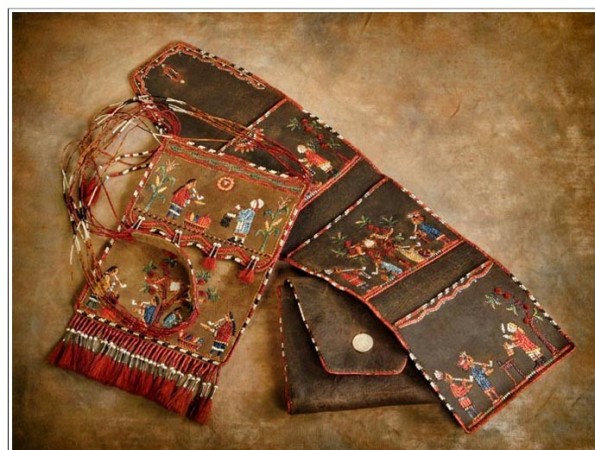Embroidery in Different Culture
England
Embroidery became popular in England in the Middle Ages, when artisans started to use it to decorate royal tapestries and garments such as dresses and robes. Embroidered tapestries were often used to record history, and the craftsmen used rich metal-based thread to add depth and literal richness to the picture. Embroidery continued to be an important part of the nobility’s wardrobe, with opulent designs in both monochromatic and vibrantly colored palettes. As embroidery continued through the 16th and 17th centuries, designed became more subtle and focused on pictures and stories focusing on morality. British designs reflected the natural, industrial, and pastoral themes found in their culture, many of which can still be seen in their work today.
Embroidery is a popular crafting activity, as well as a big style trend at the moment. Embroidery has a long history, and has been part of many different cultures around the world for centuries. These different embroidering traditions now come together to make the embroidery techniques and styles that we use today. Even in the works of prominent fashion and home decor designers, you’ll see embroidery that is influenced by various cultures around the world. Here are some of the cultures that are most known for their embroidery work and how they use it.
China

Ancient Chinese was known for its use of lavish designs and beautiful craftsmanship, and embroidery is no exception. They have been embroidering for thousands of years BC, and were one of the first cultures to actually use these techniques. They originally used silk thread to embroider. There are four different schools of traditional Chinese embroidery: Shu, Xiang, Su, and Yue. Shu embroidery uses extremely tight stitches and plenty of nature motifs. Xiang embroidery is very delicate and is created to resemble a painting from far away, using broad, vibrant landscapes and patterns. Su embroidery uses extremely delicate stitching, and uses mixes of colors to get the exact desired shade. Yue embroidery is very eclectic, making use of many different techniques, and often depicts mystical themes.
Native America

The tribes of Native America have also been using rich and vibrant embroidery to embellish their goods for centuries. The initially used porcupine quills to embroider on skins, but later began using cloth as well. They used embroidery to decorate virtually everything in their society, ranging from clothing to useful items like medicine bags. Native American embroidery designs are very distinctive in their use of bright colors like reds, blues, and yellows, as well as their use of angular patterns. Many Native American designs are symmetrical and have an abstract design, as opposed to other cultures that use lavish nature patterns. They often embellished their designs with beading as well, something that can still be seen today in many Native American tribes.
Middle East
Parts of the countries that are now known as Pakistan, Afghanistan, and Iran are known for having their own style of needlework as well. In particular, this area is known as the origin of some of the world’s most beautiful rugs and tapestries. Islamic crafters also used embroidery on their clothes and other fabric items, as well as religious items. This embroidery style is known for rich, deep colors like maroons and burgundies. They often use small, detailed natural themes like flowers, birds, and trees. Middle Eastern crafters used many techniques that are popular with embroiderers today, like herringbone and chain stitch. While embroidery is less common in the Middle East now, old embroidered goods are now highly valued and very expensive. These are just a few of the many prominent countries and cultures that used embroidery as a form of decoration and self-expression.
Vietnamese Royal Embroidery

Although the royal embroideries of some Asian countries like Vietnam, Japan, China, and Korea have similarities and differences, Vietnamese royal embroidery still has its own characteristics, which can easily be distinguished from the art of other countries. Lee Jung Hee, an artist from the Republic of Korea, who is famous for her sophisticated embroidered pieces, said: “There is a big difference between Vietnamese and Korean embroidery art. When looking at Vietnamese traditional patterns, it seems like all the objects, animals, and plants are real, whereas the Korean royal embroidery art symbolizes these motifs that wish longevity, luck, and wealth. However, in Korea, there are some special colors that were used only for members of the royal family, such as red and yellow.”




